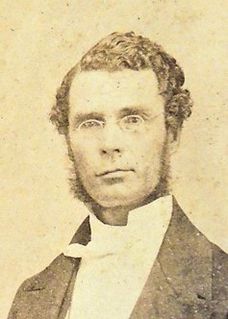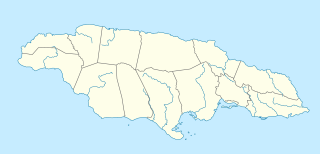Related Research Articles

Saint Ann is the largest parish in Jamaica. It is situated on the north coast of the island, in the county of Middlesex, roughly halfway between the eastern and western ends of the island. It is often called "the Garden Parish of Jamaica" on account of its natural floral beauty. Its capital is Saint Ann's Bay. Saint Ann comprises New Seville, the first Spanish Settlement in Jamaica.

The Morant Bay rebellion began with a protest march to the courthouse by hundreds of people led by preacher Paul Bogle in Morant Bay, Jamaica. Some were armed with sticks and stones. After seven men were shot and killed by the volunteer militia, the protesters attacked and burned the court house and nearby buildings. A total of 25 people died. Over the next two days, peasants rose up across St. Thomas-in-the-East parish and controlled most of the area.

Saint Thomas, once known as Saint Thomas in the East, is a suburban parish situated at the south eastern end of Jamaica, within the county of Surrey. It is the birthplace of the Right Honourable Paul Bogle, designated in 1969 as one of Jamaica's seven National Heroes. Morant Bay, its chief town and capital, is the site of the Morant Bay Rebellion in 1865, of which Bogle was a leader.

Saint Elizabeth, one of Jamaica's largest parishes, is located in the southwest of the island, in the county of Cornwall. Its capital, Black River, is located at the mouth of the Black River, the widest on the island.

Portland, with its capital town Port Antonio, is a parish located on Jamaica's northeast coast. It is situated to the north of St Thomas and to the east of St Mary in Surrey County. It is one of the rural areas of Jamaica, containing part of the Blue Mountains, where the Jamaican Maroon communities of Moore Town and Charles Town, Jamaica are located.

St. James is a suburban parish, located on the north-west end of the island of Jamaica in the county of Cornwall. Its capital is Montego Bay. Montego Bay was officially named the second city of Jamaica, behind Kingston, in 1981, although Montego Bay became a city in 1980 through an act of the Jamaican Parliament. The parish is the birthplace of the Right Excellent Samuel Sharpe, one of Jamaica's seven National Heroes.

George William Gordon was a wealthy mixed-race Jamaican businessman, magistrate and politician, one of two representatives to the Assembly from St. Thomas-in-the-East Parish. He was a leading critic of the colonial government and the policies of Jamaican Governor Edward Eyre.

Hanover is a parish located on the northwestern tip of the island of Jamaica. It is a part of the county of Cornwall, bordered by St. James in the east and Westmoreland in the south. With the exception of Kingston, it is the smallest parish on the island. Hanover is the birth parish of Alexander Bustamante, labour leader, first head of government of Jamaica under universal suffrage, and one of seven Jamaican National Heroes. Its capital is Lucea.

Morant Bay is a town in southeastern Jamaica and the capital of the parish of St. Thomas, located about 25 miles east of Kingston, the capital. The parish has a population of 94,410.

Duckenfield, Jamaica is a village in St Thomas, in south-east Jamaica. It is named after the sugar plantation on which it is located. It is a very poor community, but it has grown substantially in recent years. There were plans to build an international airport in the vicinity in order to open the eastern end of the island to tourism, but these have since been shelved.
Simon Watson Taylor was a Liberal Party politician in the United Kingdom. He was Member of Parliament (MP) for Devizes in Wiltshire from 1857 to 1859.

Hibbert House, also known as Headquarters House, is the head office of the Jamaica National Heritage Trust. It is located at 79 Duke Street in Kingston, Jamaica. It was built by Thomas Hibbert, a wealthy young English merchant, in 1755 to serve as his residence. Hibbert migrated to Kingston in 1734, at a time when Jamaica was becoming the largest and wealthiest of the British Caribbean islands and the largest single destination of African slaves. In the early 1750s, he formed a partnership with Nathaniel Sprigg to serve as factors for slaves, purchasing them off the ships from Africa and reselling them to planters and others in Jamaica. Hibbert also helped found a major West Indian house in London, trading in sugar and rum.

Yallahs is a town located on the southeastern coast of Jamaica in the parish of St Thomas and is home to an estimated 10,000 inhabitants. The town was recorded as "Yealoth" in the 1662 census. It may have received its name from Captain Yallahs, a 1671 privateer, or the privateer may have received his pseudonym from the town. Yallahs' name could have simply come from the Spanish word 'yalos', meaning frost, because the high white cliffs in that area have been thought to give an appearance of frost.

Golden Grove is a settlement in the parish of Saint Thomas, Jamaica. Historically a sugar plantation, it had a population of 3,057 in 2009.

Morant Bay High School in Morant Bay, St Thomas, Jamaica was founded in 1961.
George Watson-Taylor (1771–1841), of Cavendish Square, Middlesex and Erlestoke Park, near Devizes, Wiltshire, was an English sugar planter, slave owner and politician.

Sir John Taylor FRS was a fellow of the Royal Society who was created a baronet of Lysson Hall in Jamaica. He lived in London but he died in Jamaica.

Saint David Parish was one of the historic parishes of Jamaica created following colonisation of the island by the British. It was in the east of the island in Surrey County

Simon Taylor was a Scottish slave owner, the wealthiest sugar planter in the Colony of Jamaica, and one of the wealthiest men ever to have lived in the British Empire. Sir George Nugent, 1st Baronet, who was Governor of Jamaica between 1802-6, described Taylor as "the richest proprietor in the island". At the time of his death, Taylor's estate was estimated at probably worth over £1 million. His brother was Sir John Taylor.
References
- 1 2 Jemmott, Dr Jenny. "PARISH HISTORY PROJECT: A HISTORY OF ST. THOMAS" (PDF). JN FOUNDATION. Retrieved 25 May 2020.
- ↑ "Princess Margaret Hospital". SERHA. Retrieved 25 May 2020.
- ↑ "Jamaica Observer Limited". Jamaica Observer. Retrieved 25 May 2020.